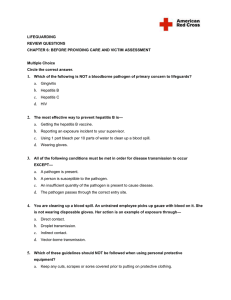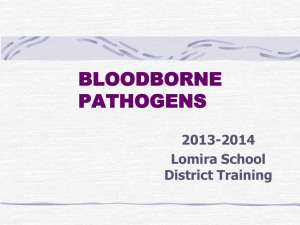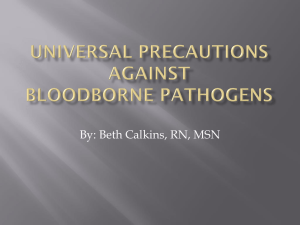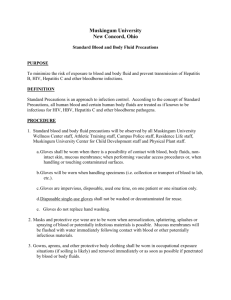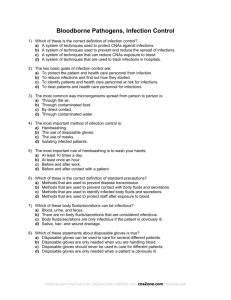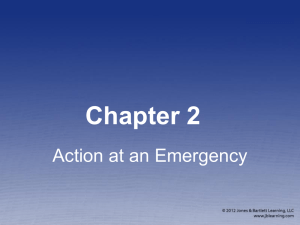Chapter-6-Teacher
advertisement
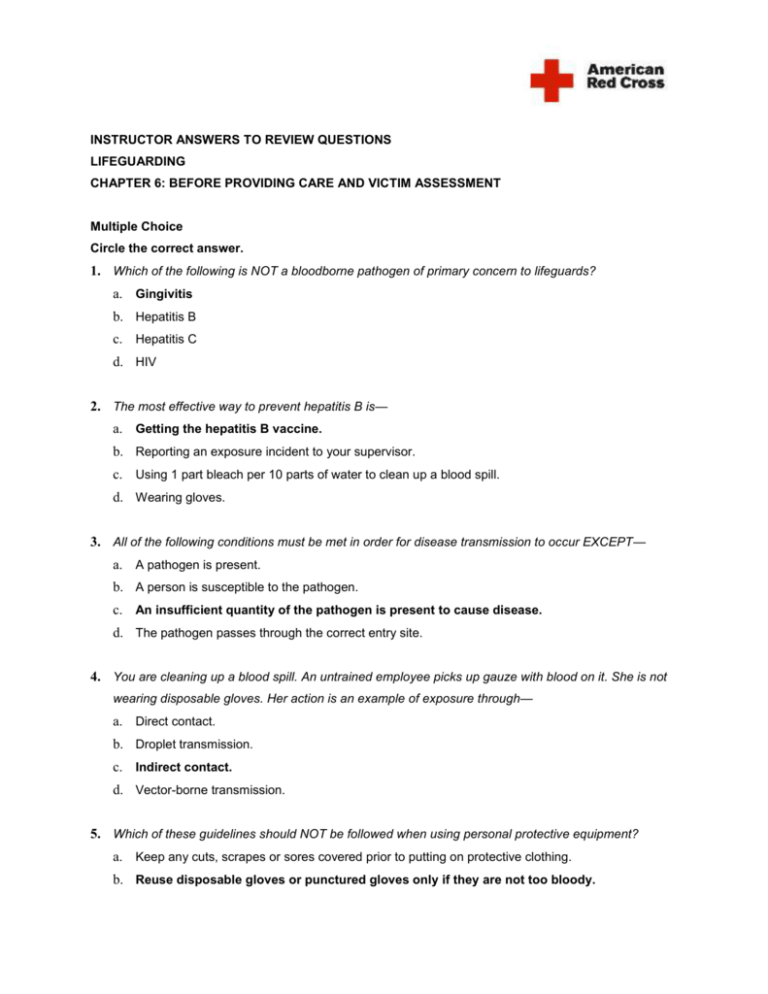
INSTRUCTOR ANSWERS TO REVIEW QUESTIONS LIFEGUARDING CHAPTER 6: BEFORE PROVIDING CARE AND VICTIM ASSESSMENT Multiple Choice Circle the correct answer. 1. Which of the following is NOT a bloodborne pathogen of primary concern to lifeguards? a. Gingivitis b. Hepatitis B c. Hepatitis C d. HIV 2. The most effective way to prevent hepatitis B is— a. Getting the hepatitis B vaccine. b. Reporting an exposure incident to your supervisor. c. Using 1 part bleach per 10 parts of water to clean up a blood spill. d. Wearing gloves. 3. All of the following conditions must be met in order for disease transmission to occur EXCEPT— a. A pathogen is present. b. A person is susceptible to the pathogen. c. An insufficient quantity of the pathogen is present to cause disease. d. The pathogen passes through the correct entry site. 4. You are cleaning up a blood spill. An untrained employee picks up gauze with blood on it. She is not wearing disposable gloves. Her action is an example of exposure through— a. Direct contact. b. Droplet transmission. c. Indirect contact. d. Vector-borne transmission. 5. Which of these guidelines should NOT be followed when using personal protective equipment? a. Keep any cuts, scrapes or sores covered prior to putting on protective clothing. b. Reuse disposable gloves or punctured gloves only if they are not too bloody. c. Use a breathing barrier when giving rescue breaths to a person. d. Wear disposable gloves whenever providing care. 6. You can protect yourself from disease transmission by doing all of the following EXCEPT— a. Avoiding direct or indirect contact with blood and other potentially infectious materials. b. Cleaning and disinfecting all equipment and work surfaces possibly soiled by blood or other body fluids. c. Performing CPR or rescue breathing without a breathing barrier. d. Thoroughly washing your hands after providing care. 7. Work practice controls include— a. Not eating or drinking when you are in an area where you may be exposed. b. Placing sharp items in the trash can. c. Removing soiled gloves and placing them in the office trash can. d. Reusing disposable gloves after rinsing them with water. 8. Which of the following best describes universal precautions? a. Universal precautions detail the 6-step procedure for proper glove removal. b. Universal precautions help you identify the symptoms and modes of transmission of bloodborne pathogens. c. Universal precautions require that all blood and other potentially infectious materials be treated as if known to be infectious for hepatitis B, hepatitis C, HIV or other bloodborne pathogens. d. Universal precautions specify safe hand-washing practices in the workplace. 9. An exposure control plan— a. Is a confidential plan that should not be shared with employees. b. Is the written program for minimizing or eliminating employee exposure incidents. c. Means that every individual employee in the workplace must handle blood or other potentially infectious body fluids. d. Requires that employers provide free immunizations for people exposed to influenza. 10. If you are exposed to blood or other body fluids— a. Apply ice to the exposed area. b. Report the incident to your supervisor after a day. c. Wait to see if you become ill before reporting the incident. d. Wash or flush the exposed area immediately. 11. One of the first steps to follow during an emergency is— a. Conducting an initial assessment. b. Documenting what happened. c. Planning for an emergency. d. Transporting the victim to the hospital. 12. Why should you conduct an initial assessment in every situation? a. To identify any life-threatening conditions b. To protect the victim and bystanders from dangers at the scene c. To protect you from legal actions d. To reassure the victim 13. EMS personnel should be summoned for all of the following conditions EXCEPT— a. A yellowing of the skin. b. Breathing problems (difficulty breathing or no breathing). c. Chest pain or discomfort that lasts 3 to 5 minutes or that goes away and comes back. d. Severe headache or slurred speech. 14. Personal protective equipment such as disposable gloves help to— a. Maintain breathing. b. Protect against disease transmission. c. Reduce the amount of oxygen in a victim’s blood. d. Restart the heart. 15. The steps you perform in an initial assessment are— a. Check for consciousness, signs of life, a pulse and severe bleeding. b. Perform 5 abdominal thrusts and 5 back blows. c. Place the victim in a modified-H.A.IN.E.S. recovery position and monitor the ABCs. d. Roll the victim onto his or her back and provide rescue breaths at a rate of 1 breath about every 3 seconds. 16. You are caring for a victim in an emergency who may have ingested drugs. The victim suddenly becomes hostile, violent and threatening. As a lifeguard, what should you do? a. Attempt to restrain the victim until he or she calms down b. Continue to attempt to treat the victim because he or she needs your care c. Leave the scene, it is too dangerous to remain on site d. Remove yourself from harm, observe the victim and wait for law enforcement to arrive 17. In an emergency, move a victim only if not moving him or her will cause further harm to the victim or the rescuer. Which of the following includes examples of such a situation? a. Confined, downed power lines; moving traffic; or domestic animals b. Explosions, fire, toxic gas exposure or unstable structures in the immediate vicinity c. Rainstorms, moving traffic or power outages d. Unstable structures a block away or power outages 18. When checking for signs of life during the initial assessment, you are looking for— a. Chest and arm movement. b. Circulation and breathing. c. Circulation and chest movement. d. Movement and normal breathing. Matching 19. Match each term with the correct definition. A. Bacteria B. Bloodborne pathogens C. Hepatitis B D. Hepatitis C E. HIV F. Virus A A form of pathogen that can live outside the body and commonly do not depend on other organisms for life. E A disease in whichThe virus attacks the white blood cells are attacked and destroys the body’s ability to fight infection. is destroyedThe virus that causes acquired immunodeficiency virus (AIDS). F A common form of pathogen that depends on other organisms to live and once in the body is difficult to kill. B Bacteria and viruses present in blood and body fluids. C A liver infection that can be severe or even fatal, where vaccination is the most effective means of prevention. D The most common chronic bloodborne infection in the United States. 20. Match each term with the correct definition. A. BSI precautions/standard precautions B. Engineering controls C. Exposure control plans D. OSHA regulations and guidelines E. Universal precautions F. Work practice controls B Measures that isolate or remove a hazard from the workplace. The things used in the workplace to help reduce the risk of an exposure incident. F Practices that help reduce the likelihood of exposure by changing the way a task is carried out. The things employees do to help reduce the risk of an exposure incident. E Treating all blood and other potentially infectious materials as if they are known to be infectious. C A written program that outlines the protective measures an employer will take to eliminate or minimize exposure incidents. D Apply to employees who may come into contact with blood or other body fluids that could cause an infection and help employers meet the bloodborne pathogen standard to prevent transmission of serious diseases. A Approaches that consider all blood and body fluids to be infectious. 21. Match each term with the correct definition. A. Blanket drag B. Clothes drag C. Foot drag D. Pack-strap carry E. Two-person seat carry F. Walking assist B Used to move a clothed victim who you think may have a head, neck or back injury. F Used to help a victim who needs assistance walking to safety. C Used to move a victim too large to carry or move otherwise. E Used to carry a conscious victim who cannot walk and has no suspected head, neck or back injury. A Used to move an unconscious victim in an emergency situation when rescue equipment is limited. D Used to help move a conscious or unconscious victim with no suspected head, neck or back injury. Multiple Answers Place the correct symbol next to the correct answer. 22. Place an “E” by those measures or practices that are Engineering Controls and a “W” by those that are Work Practice Controls. W Placing sharps items in appropriate containers E Biohazard bags W Removal and disposal of soiled personal protective equipment W Cleaning and disinfecting all equipment and work surfaces possibly soiled by blood or other potentially infectious materials E Personal protective equipment E Sharps containers W Washing hands after providing care E Self-sheathing needles W Not drinking; eating; smoking; handling contact lenses; touching the eyes, nose or mouth; or applying lip balm cosmetics in areas where blood or other potentially infectious materials may be transmitted E Biohazard labels True or False Circle True or False. 23. True False Using a resuscitation mask when giving rescue breaths promotes safe practices by reducing the risk of transmitting bloodborne pathogens. Fill in the Blanks 24. Adopting preventive behavior is the best tool against exposure to hepatitis B, hepatitis C, HIV and other bloodborne pathogens. 25. Unprotected skin contact with blood-soaked bandages from a first aid incident is an example of indirect contact. 26. Wear disposable gloves whenever providing care, particularly if you may come into contact with blood or other potentially infectious materials. 27. Keep any cuts, scrapes or sores covered prior to putting on protective coverings such as a mask, eyewear and gown. 28. Change disposable gloves before providing care to a different person. 29. In addition to gloves, wear other personal protective equipment, such as protective eyewear to protect the eyes, whenever you are likely to come into contact with blood or other body fluids or while cleaning up a biohazard spill. 30. If you are a lone rescuer, Call First, meaning call 9-1-1 or the local emergency number before providing care for an unconscious adult or child age 12 or older. 31. If you are a lone rescuer, Care First for an unconscious child or infant younger than 12 years old. 32. Call First if you suspect a cardiac emergency. 33. Care First situations are likely to be related to breathing emergencies rather than cardiac emergencies. Ordering Place the following in the correct order. 34. You have responded to an emergency involving blood at your facility. After providing care, you are responsible for cleaning and disinfecting the area (a solid-surface floor). Place the seven steps in the correct order, starting with 1, that you would take to disinfect the area. 2 Clean up spills immediately or as soon as possible after the spill occurs. 1 Wear disposable gloves and other personal protective equipment when cleaning up spills. 4 Dispose of the absorbent material used to collect the spill in a labeled biohazard container 7 Scrub soiled boots; leather shoes; and other leather goods, such as belts, with soap, a brush and hot water. If you wear a uniform to work, wash and dry it according to the manufacturer’s instructions. 5 Flood the area with a fresh disinfectant solution of approximately 1½ cups of liquid chlorine bleach to 1 gallon of water (1 part bleach per 10 parts water), and allow it to stand for at least 10 minutes. 3 If the spill is mixed with sharp objects, such as broken glass and needles, do not pick these up with your hands. Use tongs, a broom and dustpan or two pieces of cardboard. 6 Use appropriate material to absorb the solution, and dispose of it in a labeled biohazard container. Circle the Correct Answer from the Pair 35. Hepatitis B, hepatitis C and HIV (are/are not) spread by casual contact such as shaking hands. 36. (Do/Do not) use disposable gloves that are discolored, torn or punctured. 37. (Do/Do not) reuse disposable gloves. 38. (Do/Do not) wear disposable gloves or other protective clothing or equipment away from the workplace. 39. (Do/Do not) handle items such as pens, combs or radios when wearing soiled gloves. 40. If you wear disposable gloves, you (do/do not) need to wash your hands after providing care. Short Answer 41. Name four types of exposures to blood that professional rescuers, such as lifeguards, might encounter. o o o o Injuries from needles Injuries from other sharps Direct contact (skin and mucous membrane) Indirect contact (skin and mucous membrane) 42. Give two examples of correct entry sites where transmission of bloodborne pathogens could occur from occupational exposure. o Touching blood or other body fluids directly or indirectly and having breaks in the skin o Blood splashing into eyes or mouth 43. What role do OSHA regulations play in preventing the spread of bloodborne pathogens? The regulations require employers to minimize or eliminate hazards from the workplace that may place employees in contact with infectious materials and prevent transmission of serious diseases in situations in which employees could come into contact with blood or other body fluids as part of their occupational duties. 44. List at least five types of personal protective equipment used in the facility to keep lifeguards from directly contacting infected materials. Answers could include any five of the following: o o o o o o o o Resuscitation masks Disposable gloves Protective eyewear Protective footwear Gowns Face shields BVMs Rubber gloves 45. List the six steps necessary to correctly wash hands after providing care. 1. Wet hands with warm water. 2. Apply liquid soap to hands. 3. Rub hands vigorously for at least 15 seconds, covering all surfaces of the hands and fingers. Use soap and warm running water. Scrub nails by rubbing them against the palms. 4. Rinse hands with water. 5. Dry hands thoroughly with a paper towel. 6. Turn off the faucet using the paper towel. 46. While providing care to a victim you note that you were exposed by direct contact to the victim’s blood or other potentially infectious material. What must you do immediately? o o o o Immediately report the incident to your supervisor or have someone do it for you. Wash, flush or irrigate the exposed area of your body. Write down what happened. Get immediate medical attention. 47. List the four general steps to follow in an emergency occurring on land. 1. Size up the scene 2. Perform an initial assessment 3. Summon EMS personnel, if necessary 4. Perform a secondary assessment 48. List in the correct order the four steps necessary to properly complete an initial assessment. 1. Check the victim for consciousness 2. Check for signs of life (movement and breathing) 3. Check for a pulse 4. Check for severe bleeding 49. Name three situations in which a lone responder would Care First, that is, provide 2 minutes of care, then call 9-1-1 or the local emergency number. Answers could include any three of the following: o o o o An unconscious child or infant (younger than 12 years old) Any victim of a drowning or nonfatal submersion Any victim who has suffered cardiac arrest associated with trauma Any victim who has taken a drug overdose
